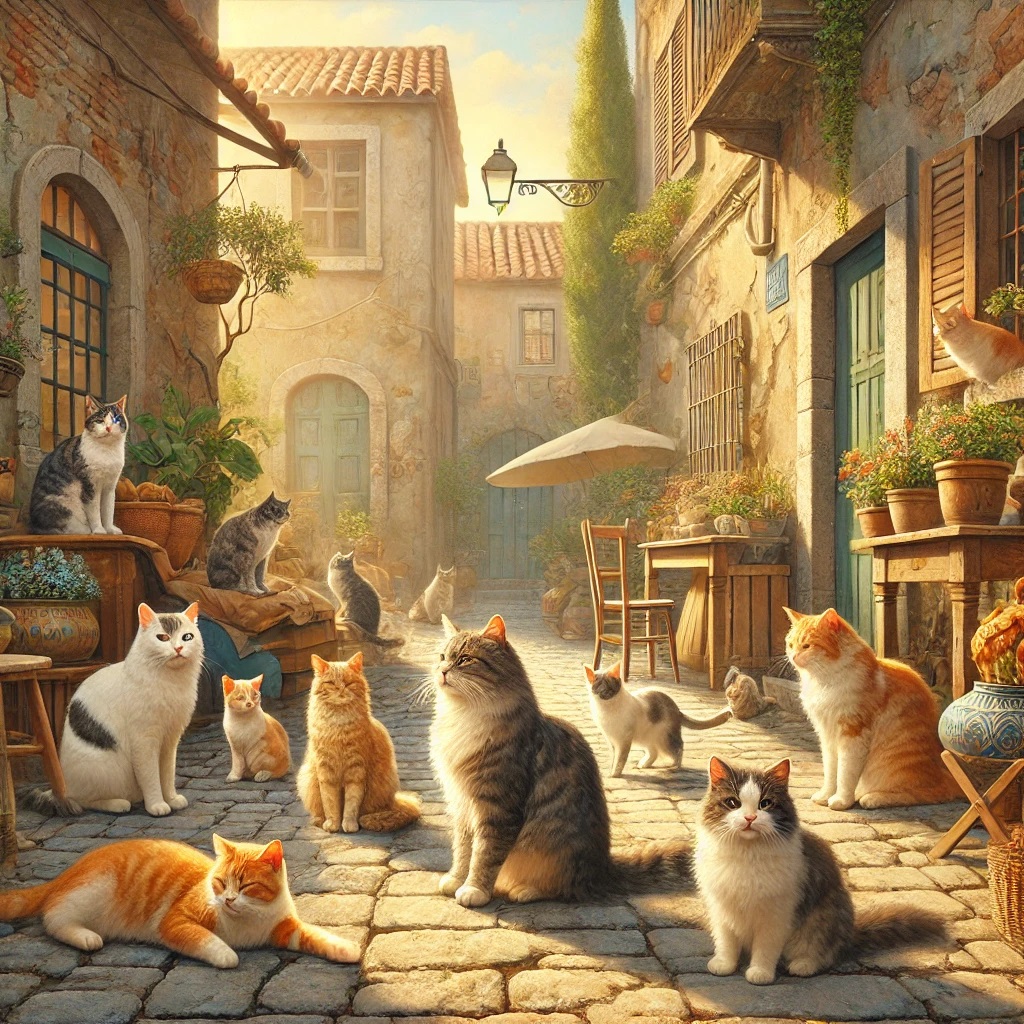If you’ve ever been captivated by the grace and majesty of felines, you’ll be thrilled to explore the world of big cat breeds! These extraordinary cats not only boast impressive sizes but also endearing personalities that make them ideal companions. From the striking Maine Coon to the playful American Bobtail, each breed brings its unique charm and quirks. In this post, we’ll journey through the top 15 big cat breeds, highlighting their characteristics, care needs, and what makes them gentle giants in the feline kingdom. Get ready to discover your new furry friend!
Maine Coon: The Gentle Giant
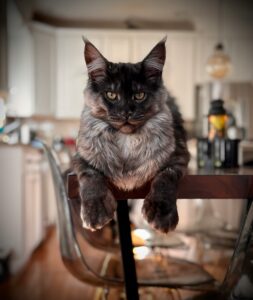
The Maine Coon is often regarded as a true treasure among felines. These magnificent cats are known for their striking appearance, playful demeanor, and gentle disposition. Often referred to as “gentle giants,” Maine Coons are one of the largest domesticated cat breeds, capturing the hearts of pet lovers around the globe. Here’s an in-depth look at this remarkable breed.
Physical Characteristics
Maine Coons are primarily distinguished by their large stature and unique physical traits:
- Size: Adult males typically weigh between 13 to 18 pounds, while females range from 8 to 12 pounds.
- Fur: Their long, thick coat is water-repellent, making them suitable for different climates. The fur is soft and silky, with a ruff of fur around the neck that resembles a lion’s mane.
- Ears: They possess tufted ears, often tipped with hair, which further enhances their regal look.
- Tail: Their bushy tails are often as long as their bodies, providing extra warmth in cold weather conditions.
- Eyes: Maine Coons have large, expressive eyes that come in various shades, including gold, copper, and green.
Temperament and Behavior
Despite their formidable size, Maine Coons are renowned for their gentle and playful nature. Here’s how their temperament stands out:
- Friendly: They are known to be very sociable, enjoying the company of both people and other pets. This breed typically gets along well with children and other animals.
- Intelligent: Maine Coons are intelligent cats, often curious, and engaging in playful behaviors. They can learn tricks and even enjoy playing fetch, similar to dogs.
- Affectionate: These cats are known for forming strong bonds with their owners. They often exhibit their affection by following you around the house or curling up in your lap for a nap.
Care and Maintenance
Maintaining a Maine Coon’s health and appearance requires some commitment, but their loving nature makes it worthwhile. Here are a few key care guidelines:
- Grooming: Regular brushing is essential to prevent matting and maintain the health of their coats. Aim for once or twice a week.
- Diet: Feeding them a high-quality diet rich in protein will help support their muscular build and overall health.
- Regular Vet Visits: Annual check-ups are crucial to monitor for common health issues, such as hip dysplasia and hypertrophic cardiomyopathy.
Quick Facts
| Feature | Description |
|---|---|
| Average Weight | 8-18 pounds |
| Lifespan | 12-15 years |
| Coat Length | Medium to long |
| Origin | United States |
| Activity Level | Moderately active |
In Conclusion
Maine Coons exemplify the ideal feline companion with their affectionate personalities, striking appearances, and gentle playfulness. These large cats not only provide companionship but also stand out as a notable and majestic presence in any household. Adopting a Maine Coon is truly welcoming a loving giant into your life, guaranteed to fill your home with warmth and joy.
Ragdoll: The Laid-Back Companion
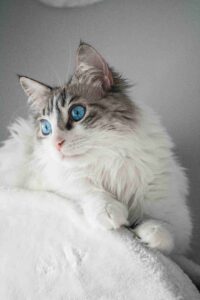
The Ragdoll is a breed that perfectly embodies the concept of a gentle companion, making it a popular choice among feline enthusiasts. These charming cats are known for their affectionate and easygoing nature, which combines gently with their striking appearance. As you delve deeper into the world of Ragdolls, you’ll discover why they are celebrated as ideal furry friends for families and individuals alike.
Key Characteristics of Ragdolls
Ragdolls are often characterized by their stunning appearance and warm personalities. Below are some of their defining traits:
| Trait | Description |
|---|---|
| Size | Ragdolls are large, muscular cats, typically weighing between 10 to 20 pounds. |
| Coat | They possess semi-long, silky fur that is easy to maintain with regular grooming. |
| Color Patterns | Common colors include blue, chocolate, lilac, and cream, typically in color point patterns. |
| Temperament | Ragdolls are exceptionally friendly, affectionate, and often enjoy being carried around. |
| Lifespan | They generally live between 12 to 15 years, fostering strong bonds with their owners. |
Temperament: The Heart of the Ragdoll
One of the standout qualities of Ragdolls is their temperament. Here are some notable characteristics:
- Gentle Nature: Ragdolls are remarkably tolerant and patient, making them suitable for homes with children and other pets. Their laid-back demeanor allows them to adapt easily to various living environments.
- Affectionate Behavior: Known for their loving disposition, they often seek out human interaction and enjoy being close to their owners. They have a unique tendency to go limp when picked up, which is where their name, “Ragdoll,” originates.
- Playful Yet Calm: While they enjoy playful activities such as chasing toys or light feather wands, they balance this with moments of serenity, often lounging beside you or curling up in your lap.
Grooming and Care
Caring for a Ragdoll isn’t overly demanding, but regular grooming is essential to maintain their gorgeous coat. Here’s a simple guide to help keep your Ragdoll happy and healthy:
- Brushing: Brush at least once a week to minimize matting and reduce shedding, particularly during the spring and fall.
- Bathing: Occasional bathing can help maintain their coat, although they are generally good at self-grooming.
- Diet: Ensure a balanced diet tailored to your cat’s age, weight, and health requirements. High-quality cat food, along with fresh water, keeps them vital and healthy.
- Veterinary Check-Ups: Routine vet visits are crucial for maintaining overall health and addressing any breed-specific concerns.
Ideal Living Environment
Ragdolls do best in environments that provide ample space for them to roam and play freely while offering cozy spots for relaxation. Some tips for creating an inviting home for these charming companions include:
- Provide vertical spaces, such as cat trees or shelves, allowing them to survey their environment from above.
- Ensure the home is calm, as Ragdolls thrive in peaceful settings with limited loud noises.
- Socialize them regularly to keep their friendly demeanor intact—long periods of solitude can lead to stress in these social cats.
Overall, Ragdolls exemplify the characteristics of a perfect laid-back companion with their affectionate nature, striking appearance, and adaptability. If you’re seeking a gentle giant to share your home with, a Ragdoll cat could just be the ideal fit.
Savannah: The Wild at Heart
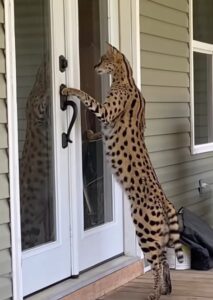
When it comes to charm and exotic allure, few breeds can match the Savannah cat. Known for its wild appearance coupled with a playful personality, the Savannah is indeed a feline that embodies the spirit of the wilderness, making it a captivating choice for cat lovers. This breed is a hybrid of the domestic cat and the serval, a wild African cat, which contributes to its striking features and lively demeanor.
Physical Characteristics
The aesthetic of the Savannah cat is nothing short of remarkable. Here are some key features that make this breed stand out:
- Size: Savannahs are among the largest of domestic cats, typically weighing between 12-25 pounds, depending on their generation and upbringing.
- Coat: Their coat is dense and has a distinct spotted pattern, reminiscent of a leopard. The base color ranges from gold to creamy yellow, adorned with dark spots that give them a wild appearance.
- Ears: A defining trait is their large, upright ears that are reminiscent of their serval ancestry, which also enhances their hearing capabilities.
- Body Structure: They possess long, lean bodies with powerful legs, allowing them to jump and run with remarkable agility.
Personality Traits
The Savannah cat is more than just a pretty face; its personality is a blend of adventurous and affectionate characteristics. Here’s what you can typically expect from a Savannah:
- Energetic: Highly active and playful, the Savannah requires ample playtime and mental stimulation. They love engaging in interactive games and can often be seen chasing after toys or even fetching them.
- Social: These cats are known to bond closely with their human companions. They thrive on interaction and often seek out attention, making them affectionate pets.
- Curious: Savannahs possess an insatiable curiosity. They explore their surroundings with vigor, and their playful demeanor can sometimes lead them into mischief.
- Intelligent: Their high intelligence allows them to learn tricks and commands easily. They can even be leash-trained, which allows owners to take them out for walks.
Care Needs
To ensure that your Savannah cat thrives in a home environment, it is essential to understand their care requirements:
- Space: These cats need ample space to roam and play. A home with plenty of vertical spaces such as cat trees, shelves, or tall scratching posts is ideal.
- Diet: High-quality protein-rich diet is vital. A mix of wet and dry food can help keep them nourished and energetic.
- Playtime: Daily interactive play sessions, including puzzle toys and feather wands, can help meet their need for mental stimulation and physical activity.
Comparison with Other Breeds
| Feature | Savannah | Maine Coon | Ragdoll |
|---|---|---|---|
| Size | Large (12-25 lbs) | Large (10-25 lbs) | Medium to Large (8-20 lbs) |
| Coat | Short, spotted | Long, shaggy | Semi-long, soft |
| Energy Level | High | Moderate | Low |
| Affection Level | High | Very High | Extremely High |
“Savannah cats bridge the gap between the untamed wild and the loving, domesticated companion. Their unique blend of beauty, intelligence, and social nature makes them truly one-of-a-kind.”
In summary, the Savannah cat is a unique breed that offers feline fans both aesthetics and companionship. Their wild at heart nature, combined with their affectionate disposition and notable physical characteristics, ensures they are a delightful addition to the families that can provide them with the engagement and space they crave.
Siberian: The Cuddly Furball
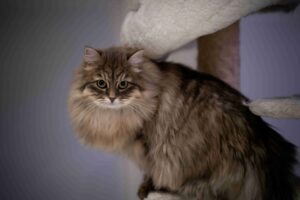
The Siberian cat, an enchanting breed originating from the forests of Siberia, is celebrated for its striking appearance and friendly demeanor. Known for their thick, water-repellent fur and robust build, these felines have adapted beautifully to cold climates. These characteristics not only make them visually appealing but also contribute to their reputation as loving companions.
Physical Attributes
The Siberian cat exemplifies a large and muscular physique. Below is a detailed breakdown of their physical traits:
| Trait | Description |
|---|---|
| Size | Medium to large, typically weighing 8-20 pounds |
| Body Structure | Strong and sturdy with a rounded appearance |
| Fur Type | Long, dense, and triple-layered |
| Eyes | Large, expressive, and almond-shaped |
| Color Variations | Comes in various colors including tabby, solid, and more |
Temperament
Siberians are known for their affectionate nature and loyal disposition. Characteristics that make them ideal companions include:
- Sociable: They thrive on interaction, enjoying the company of humans and other pets alike.
- Intelligent: Siberians are quick learners and often engage in playful antics that display their cleverness.
- Playful: Despite their size, they retain a playful spirit well into adulthood, always seeking new adventures.
Grooming and Care
While these cats possess a luxurious coat, their grooming requirements are manageable due to the unique structure of their fur:
- Brushing: Regular brushing (once a week) is recommended to prevent matting and reduce shedding, especially during seasonal changes.
- Bathing: They usually do not require frequent baths, as their skin has natural oils that keep their coat clean.
- Dental Care: Regular dental check-ups are essential to maintain their overall health.
Health Considerations
Siberians are generally healthy cats, but like all breeds, they can be prone to certain genetic issues. Some common health concerns to be mindful of include:
- Hypertrophic Cardiomyopathy (HCM): A heart condition that affects many cat breeds. Regular veterinary check-ups are vital.
- Joint Issues: Their weight, combined with their playful nature, necessitates attention to joint health, especially as they age.
Living Environment
Siberians adapt well to various living conditions, making them suitable for apartments and houses alike. Some aspects to consider include:
- Space: While they are adaptable, providing ample room for play helps keep them mentally and physically stimulated.
- Safety: Like any cat, they should be kept indoors or in a secure outdoor area to protect against potential dangers.
Summary of Key Features
In short, Siberian cats are the embodiment of the affectionate and engaging pet. Their:
- Thick coats
- Playful temperament
- Strong bonds with their human companions
exemplify why they are one of the most beloved breeds. With the right care and attention, Siberian cats can enrich your life, providing companionship and joy for many years to come. Their gentle nature makes them not only cuddly furballs but also perfect additions to any family.
British Shorthair: The Classic Gentlemen
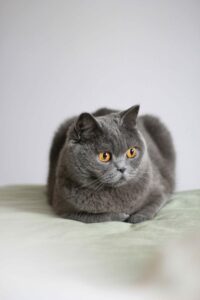
The British Shorthair is often seen as the quintessential cat, embodying all the noble features one could desire in a feline companion. Known for their distinctive round faces, dense coats, and robust stature, they are true representations of charm and dignity in the cat world. These cats are truly majestic, holding an air of sophistication that captivates the heart of many cat lovers.
Key Characteristics
The British Shorthair is characterized by several unique traits that make them stand out:
- Physical Features: They possess a stocky build with a broad chest and thick legs. Their rounded face is complemented by large, expressive eyes that come in a variety of colors, including gold, copper, and blue.
- Coat: The coat is short, plush, and requires minimal grooming, making them an ideal choice for those who prefer low-maintenance pets. The breed is known for its iconic blue coloring, but they can also be found in various other hues including cream, black, and tabby.
- Personality: Often referred to as “gentlemen,” these cats are known for their calm, easy-going demeanor. They are affectionate but not overly demanding, making them perfect companions for both singles and families.
Behavior Traits
The British Shorthair is intelligent and adaptable, displaying a wide range of behaviors that are both entertaining and endearing:
- Social Nature: They typically enjoy the company of their human companions but can also be reserved around strangers. They are not overly clingy and prefer to sit nearby rather than be on a lap.
- Playfulness: While they are laid-back, they still harbor a playful spirit. They are fond of toys and enjoy engaging in interactive play sessions, which helps keep them physically and mentally stimulated.
- Vocal Nature: Unlike some breeds, British Shorthairs are not overly vocal, which makes them a great choice for those who prefer a quieter household.
Care and Maintenance
While these cats are generally low-maintenance, certain aspects should be kept in mind to ensure a happy and healthy life for your British Shorthair:
| Care Aspect | Recommendations |
|---|---|
| Grooming | Brush once a week to reduce shedding and maintain coat quality. |
| Diet | Provide a balanced diet with high-quality cat food; consult a vet for specific dietary needs. |
| Exercise | Engage in daily play for at least 15-30 minutes to keep them active and prevent obesity. |
| Healthcare | Regular vet check-ups and vaccinations are essential for long-term health. |
Living Environment
These amazing companions thrive in environments where they can explore and interact, but they are also adaptable to smaller living spaces:
- Indoor Living: British Shorthairs excel in indoor settings, as they enjoy the protection and comfort of a home environment. Equip your living space with scratching posts and climbing structures to satisfy their exploratory instincts.
- Family Friendly: They are exceptionally well-suited for homes with children or other pets, as their gentle nature fosters an amiable atmosphere. Their patient demeanor enables them to handle the occasional tug or pull without distress, making them ideal for family life.
The British Shorthair, often iconically portrayed in literature and film, continues to captivate hearts across the globe. With their straightforward grooming needs and affectionate yet independent nature, they truly represent timeless charm in the feline world.
Norwegian Forest Cat: The Rugged Beauty
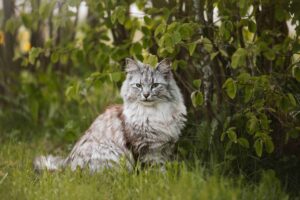
The Norwegian Forest Cat, often affectionately referred to as the “Wegie,” is a magnificent feline that boasts a captivating mix of ruggedness and beauty. With their stunning appearance and gentle temperament, these cats have garnered a devoted following among enthusiasts. Here’s an in-depth look at what makes this breed truly special.
Distinctive Features
The physical traits of the Norwegian Forest Cat are remarkable. They are known for their robust build and have an impressive coat that serves a vital purpose in their natural habitat:
- Size: They are a large breed with males typically weighing between 12 to 16 pounds, while females range from 8 to 12 pounds.
- Coat: Their long, thick double coat is water-repellent, allowing them to thrive in cold climates. The outer layer of fur is coarse, while the undercoat is soft and fluffy, providing insulation. This feature makes them particularly striking during shedding season when their coat can look even fuller.
- Ears: The breed has tall, tufted ears that lend a wild aspect to their appearance, resembling that of their forest-dwelling ancestors.
- Eyes: The Norwegian Forest Cat boasts large, almond-shaped eyes which can come in shades of green or gold, further enhancing their captivating look.
Personality Traits
Norwegian Forest Cats are not just a feast for the eyes; they possess a rich and enchanting personality that makes them ideal companions:
- Affectionate Nature: Despite their rugged exterior, these cats are known for their gentle and affectionate demeanor. They often form strong bonds with their human counterparts and enjoy being involved in family activities.
- Playfulness: They retain an energetic and playful spirit well into adulthood, indulging in games of chase or interactive playtime with their owners. This trait makes them great for families with children.
- Independent Behavior: While they enjoy companionship, Wegies are also independent. They can entertain themselves, making them suitable for busy households.
Care and Maintenance
Proper care is essential to keep a Norwegian Forest Cat healthy and happy:
Grooming:
- Their thick coat requires regular grooming to prevent matting and reduce shedding—ideally, brushing them at least once a week. During shedding seasons, more frequent grooming may be necessary.
- It’s a good idea to use a grooming tool designed for long-haired breeds.
Nutrition:
- Providing a balanced diet is crucial for this breed. They typically thrive on high-quality cat food that contains adequate protein and fat.
Health Considerations
Like any breed, Norwegian Forest Cats may face specific health challenges. Being proactive in monitoring their health can extend their lifespan, which averages about 12 to 16 years:
- Hypertrophic Cardiomyopathy (HCM): This is a condition common in many cat breeds. Regular veterinary check-ups can help detect any issues early.
- Hip Dysplasia: Though relatively rare, it is another health concern associated with larger cat breeds.
Fun Fact
“What sets the Norwegian Forest Cat apart is their natural ability to climb. Their strong, muscular bodies and sharp retractable claws make them exceptional climbers, helping them navigate their forested origins effortlessly.”
In summary, the Norwegian Forest Cat is not only a beautiful sight to behold but also a loving companion that fits well into various lifestyles. With their unique blend of ruggedness and affection, they truly epitomize the idea of a gentle giant among feline breeds.
Bengal: The Miniature Leopard
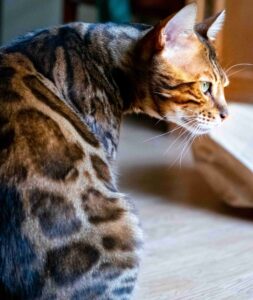
The Bengal cat, renowned for its striking coat and energetic personality, captures the interest of feline enthusiasts around the globe. With a lineage that combines domestic cats and Asian leopard cats, this breed beautifully marries wild and domestic traits. Here’s an in-depth look at the Bengal’s unique features, personality, care tips, and why they are often considered miniature versions of their wild ancestors.
Fascinating Features
Bengals are easily recognizable due to their beautiful and distinctive coats. Their fur often displays a striking marbled or spotted pattern, reminiscent of leopards in the wild.
- Coat Patterns: Bengals come in a variety of colorings, including:
- Brown spotted
- Rosetted
- Marbled
- Snow Bengal (a lighter variation)
| Coat Type | Description | Color Variations |
|---|---|---|
| Spotted | Randomly placed spots | Classic brown, charcoal, snow |
| Marbled | Swirling patterns | Brown, silver, snow |
| Rosetted | Large, outlined spots | Emerald, chocolate, blue |
Energetic and Playful Personality
Bengals are known for their playful and highly energetic demeanor. They require more stimulation and exercise than many other breeds, making them an excellent companion for active families or individuals. Here are some personality traits of Bengals:
- Curious: They love to explore their environment, often getting into places where they shouldn’t.
- Affectionate: Bengals form strong bonds with their owners and enjoy spending time with them, whether through play or snuggling.
- Intelligent: Due to their quick learning capability, they can be trained for basic commands and even play fetch.
Care and Maintenance
Due to their energetic nature, Bengals need a structured environment that keeps them engaged. Here are some care tips essential for their well-being:
- Space to Roam: Provide ample room for play and exploration, ideally with access to secure outdoor spaces.
- Interactive Toys: Invest in puzzle feeders and toys that encourage their natural hunting instincts.
- Regular Grooming: While their coats are relatively low maintenance, occasional brushing will keep their fur healthy and shiny.
Health Considerations
Bengals are generally healthy cats but, like all breeds, can be prone to specific health issues. Regular veterinary check-ups can help ensure a long and healthy life. Some common health considerations include:
- Hypertrophic Cardiomyopathy (HCM): A genetic heart condition that may affect this breed.
- Progressive Retinal Atrophy (PRA): A genetic disease that can lead to blindness, although carriers usually adapt well to the condition.
In summary, Bengals are truly captivating cats that blend the alluring aesthetics of leopards with the charm of domestic felines. Their playful nature, combined with their stunning appearance, makes them a beloved choice for those looking for an active and engaging companion. Choosing a Bengal is not just about their looks; it’s about fostering a thriving environment where their unique personality can truly shine. Whether you’re ready for a fun-loving explorer or an affectionate lap cat, Bengals fit seamlessly into active households, enlivening any space with their bold character and playful antics.
Chartreux: The French Feline
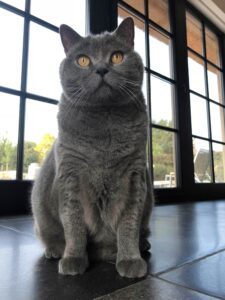
The Chartreux cat is a fascinating blend of charm, history, and endearing personality, making it one of the most sought-after feline companions. Known for its robust body and striking copper or gold eyes, this breed has several unique traits that distinguish it from other domestic cats. Rooted in French culture, the Chartreux is not just beautiful; it also boasts a rich history and a captivating demeanor.
Characteristics of the Chartreux
- Physical Appearance: The Chartreux is notable for its muscular build and dense, water-repellent coat that feels like soft wool. Their fur is typically blue-gray, which gives them a unique and eye-catching appearance. Here are some key features:
- Size: Medium to large, weighing between 8 to 15 pounds.
- Fur: Short and plush, with a double coat that is thick, insulating, and soft to the touch.
- Eyes: Normally characterized by their vivid orange or copper color, which adds to their beauty.
- Temperament: This breed is often described as being sweet-natured and gentle. Chartreux cats are known for their kind disposition, making them ideal companions. Their personality traits include:
- Affectionate: Form strong bonds with their families.
- Playful: Enjoy interactive play but are not overly hyperactive.
- Intelligent: Quick learners that thrive on mental stimulation.
Care Requirements
Taking care of a Chartreux is relatively straightforward, yet they do require some specific considerations to maintain their health and happiness:
- Grooming: Though they have a dense coat, they require minimal grooming. Regular brushings, ideally once a week, help reduce shedding and remove any loose fur.
- Diet: A high-quality cat food rich in protein supports their robust physique. Ensure that their diet is balanced to prevent obesity.
- Exercise: Daily playtime is essential. Incorporate toys, climbing structures, or interactive games to keep them agile and mentally stimulated.
History and Origin
Chartreux cats trace their lineage back to France, embodying various legends and tales throughout history. They are believed to have originated in the region of Chartreuse, making them an integral part of French folklore. They were once associated with Carthusian monks, who were thought to have cared for and bred these cats, whiling away their time in contemplative reflection alongside their feline companions.
Health Considerations
Like all cat breeds, the Chartreux can be predisposed to certain health issues. Regular vet check-ups and attention to their health needs are vital. Common concerns might include:
| Health Issue | Description |
|---|---|
| Hip Dysplasia | A genetic condition where the hip joint doesn’t fit properly. |
| Urinary Tract Issues | Prone to kidney and bladder problems, so hydration is essential. |
| Obesity | A risk if they are not exercised sufficiently. |
In Summary
The Chartreux is an embodiment of French elegance, with a charming personality to match. Known as the gentle giants of the feline world, they are perfect for families or individuals looking for a loyal companion with a laid-back attitude. This breed’s unique blend of physical attributes, charming temperament, and fascinating history makes them a delightful addition to any home. If you’re considering bringing a cat into your life, the Chartreux certainly deserves your attention!
American Bobtail: The Playful Spirit
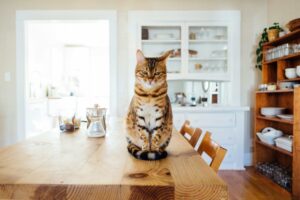
American Bobtail cats are a unique breed known for their playful temperament and intriguing appearance. With their distinctive bobbed tails and athletic build, these cats are a delightful addition to any family. They possess a dynamic personality that embraces fun, making them a perfect companion for children and active households.
Physical Characteristics
The American Bobtail boasts an athletic and robust frame that is both appealing and functional. Here’s a snapshot of their key features:
- Size: Medium to large, typically weighing between 7 to 15 pounds.
- Coat: Available in both long-haired and short-haired varieties, their fur is often dense and may vary in color and pattern.
- Tail: The most distinctive trait, featuring a short, stubby bobtail that can be about one-quarter to one-half the length of a typical cat’s tail.
- Eyes: Large, expressive eyes that can come in a range of colors, giving them an inquisitive look.
- Build: Muscular and powerful body structure, perfect for climbing and exploring.
Temperament and Behavior
“American Bobtails are playful and intelligent. Their friendly demeanor makes them well-suited for families, as they thrive on social interaction and playtime.”
These cats are known for their affectionate nature and loyalty to their owners. Here are some highlights of their temperamental traits:
- Playfulness: They retain a kitten-like enthusiasm well into adulthood. Whether it’s chasing after toys, playing fetch, or engaging in interactive games, these cats never shy away from having fun.
- Adaptability: Known for their ability to adjust to new environments, American Bobtails can easily fit into various lifestyles. They’re equally content in a busy household or a quiet apartment.
- Intelligence: This breed is highly intelligent, often learning tricks and commands quickly. They enjoy mental challenges, which can be provided through puzzle toys or interactive play.
- Affectionate: American Bobtails form strong bonds with their human companions and often follow them around the house, seeking attention and cuddles.
Care and Maintenance
Taking care of an American Bobtail involves regular attention to both their health and grooming needs. Consider the following:
- Grooming:
- Long-Haired: Brush 2-3 times a week to prevent mats and tangles.
- Short-Haired: A weekly brush is typically sufficient.
- Exercise: Engage in daily play sessions to keep them physically and mentally stimulated.
- Diet: Provide a well-balanced diet focusing on high-quality protein to maintain their strong physique.
| Care Aspect | Long-Haired Bobtail | Short-Haired Bobtail |
|---|---|---|
| Grooming Frequency | 2-3 times a week | Once a week |
| Play Needs | Daily playtime | Daily playtime |
| Preferred Diet | High-protein foods | High-protein foods |
American Bobtails are not just playful spirits but also embody a unique charm that sets them apart. Their exceptional combination of loyalty, intelligence, and playfulness ensures they remain a favored choice for cat lovers seeking companionship from these remarkable felines. Whether you’re playing, cuddling, or just enjoying their presence, the American Bobtail will undoubtedly add joy and amusement to your life.
Tornado Cat (Burmese): The Enigmatic Charm
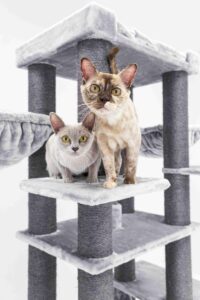
The Tornado Cat, better known as the Burmese breed, embodies a fascinating combination of elegance, playfulness, and deep emotional connections. Originating from Southeast Asia, this breed has enthralled cat lovers with its striking appearance and captivating personality. Here’s an in-depth look into the unique traits and characteristics that define this remarkable feline.
Distinctive Features
Burmese cats are admired for their sleek, muscular bodies and irresistible charm. Here are some remarkable characteristics:
- Coat: The Burmese coat is short and glossy, giving it a polished appearance. The texture is fine and satiny, enhancing the visual appeal.
- Color: These cats exhibit a variety of colors, including sable, champagne, blue, and tortoiseshell. Their striking colors often deepen with age, making them even more beautiful.
- Eyes: Large, round, and expressive, the eyes of a Burmese cat are typically amber or gold, which contrast vividly with their fur.
Table of Key Characteristics of the Tornado Cat (Burmese)
| Feature | Description |
|---|---|
| Weight | 8-14 pounds (3.5-6.5 kg) |
| Height | 10-15 inches (25-38 cm) |
| Lifespan | 10-16 years |
| Temperament | Affectionate, playful, and vocal |
| Energy Level | High; requires regular playtime |
| Intelligence | Highly intelligent and trainable |
Companionship and Behavior
One of the most alluring traits of the Burmese cat is its affection towards humans. These felines are known for forming strong bonds with their family members, often developing a special rapport with their owners. Key behavioral aspects include:
- Playful Nature: Burmese cats are incredibly playful and enjoy engaging in interactive activities. They thrive on playtime, making them ideal companions, especially for families with children.
- Vocalization: These cats are quite vocal and express themselves through a series of soft, lilting sounds, often referred to as “talking.” Their communicative nature adds another layer of interaction with their human counterparts.
- Sociability: Unlike some other varieties that may prefer solitude, the Tornado Cat is highly social. They enjoy being around people and can easily integrate into busy households.
Care and Grooming
Owning a Burmese cat comes with certain responsibilities. While they require minimal grooming due to their short hair, regular care is essential for their health and well-being.
- Brushing: A weekly brushing session is often sufficient to keep their coat in excellent condition.
- Dental Hygiene: Regular dental checkups are crucial to prevent oral health issues; consider providing dental treats or toys to aid in this maintenance.
- Interactive Play: Keep them entertained with a variety of toys, as mental stimulation is key to a happy feline.
Health Considerations
As a breed, Burmese cats are generally healthy, but they may be predisposed to specific hereditary conditions:
- Hip Dysplasia
- Hypokalemic Periodic Paralysis: A temporary paralysis condition.
- Dental Problems: Pay attention to their oral health as a preventive measure.
With their enchanting personalities and striking looks, Burmese cats continue to be a favorite among cat enthusiasts. Their affectionate demeanor and playful spirit truly exemplify the charm that makes big cat breeds irresistible companions. If you’re seeking a loving and loyal feline friend, the Tornado Cat may be the perfect addition to your home.
Himalayan: The Long-Haired Beauty
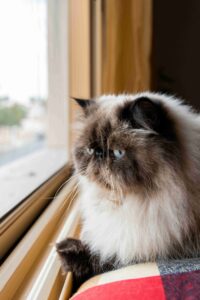
The Himalayan cat is often regarded as one of the most stunning and affectionate breeds in the feline family. With their striking features and luxurious coats, they embody grace and elegance. This breed is a long-haired variant of the Persian cat and is known for their gentle demeanor and mild temperament. Let’s delve into the enchanting world of Himalayans and uncover what makes them such beloved companions.
Characteristics of the Himalayan Cat
The Himalayan cat possesses a unique set of physical and personality traits that contribute to its charm. Here’s a detailed breakdown:
| Attribute | Description |
|---|---|
| Coat Color | Typically, Himalayans sport a color-point pattern. Their body is a lighter hue while their extremities (ears, face, paws, and tail) display a darker shade. Common colors include seal, blue, chocolate, lilac, and more. |
| Body Structure | They have a stocky, medium to large body compared to other breeds, with short legs and a flat face. Their short, rounded muzzle adds to their distinctive look. |
| Eyes | Large, round, and vivid blue eyes are characteristic of this breed, contributing to their captivating appearance. |
| Personality | Gentle, sweet-natured, and affectionate; they are known for bonding deeply with their humans. They enjoy cuddling and are often described as being calm and laid-back. |
Grooming and Maintenance
Due to their long, luxurious fur, Himalayans require regular grooming to maintain their stunning coat and prevent matting. Here are essential grooming tips to keep your feline looking fabulous:
- Daily Brushing: To prevent tangles and mats, groom your Himalayan at least once a day using a wide-toothed comb and a slicker brush.
- Bathing: Occasional baths can help in maintaining the coat’s shine. Use high-quality cat shampoo, especially designed for long-haired breeds.
- Eye Care: Some Himalayans may experience tear staining. Regularly check and gently clean the area around their eyes with a soft, damp cloth.
Health Considerations
Like any breed, Himalayans can be prone to certain health issues. It’s crucial for potential owners to be aware of these:
- Polycystic Kidney Disease (PKD): A genetic disorder that can affect kidney function, leading to serious health concerns. Regular veterinary check-ups can help in early detection.
- Dental Issues: Himalayans may be susceptible to dental problems due to their jaw structure. Providing dental treats and regular dental cleanings is advisable.
Ideal Home Environment
The Himalayan cat thrives in a serene and loving environment. Here are factors to consider when creating a suitable home for your pet:
- Quiet Spaces: Himalayan cats prefer a calm atmosphere, away from excessive noise and commotion.
- Interactive Play: Providing toys and engaging activities is essential for their mental stimulation. They enjoy feathers, strings, and interactive puzzle toys.
- Litter Box Maintenance: Keeping their litter box clean is vital, as Himalayans are notoriously particular about their hygiene.
In conclusion, the Himalayan cat is a breathtaking breed that perfectly encapsulates beauty and companionship. Their gentle nature makes them an ideal choice for families and individuals alike. Understanding their grooming needs, health considerations, and suitable living conditions can help any potential owner appreciate and nurture these long-haired beauties.
Sphynx: The Hairless Wonder
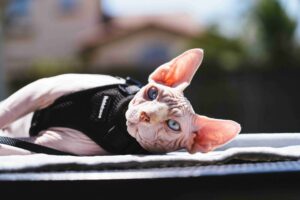
One cannot overlook the intriguing Sphynx, often dubbed “the naked cat.” Their hairless appearance is nothing short of captivating, making them some of the most unique felines around. These charming creatures have stolen the hearts of many with their striking looks and beguiling personalities.
Unique Characteristics
- Hairless Appearance: The notable lack of fur is a dominant trait of the Sphynx. While some may see this as a disadvantage, it actually allows for a very tactile experience. The skin on a Sphynx is warm and soft, with a texture akin to chamois leather.
- Body Structure: They possess a muscular build, giving them a solid look. A typical Sphynx has a round face, prominent cheekbones, and large ears that contribute to their wide-eyed, inquisitive expression.
- Skin Wrinkles: One of the defining features of the Sphynx is the abundant skin folds, which require regular maintenance to keep clean. Owners often find themselves captivated by these unique creases that make each cat visually distinct.
Temperament and Personality
Sphynx cats are not just about looks; their personalities shine just as brightly. Here’s what to expect:
- Affectionate Nature: Known for their loving demeanor, Sphynx cats often seek out the company of their human companions. They enjoy cuddling, and many will even follow you around the house, craving attention and warmth.
- Playfulness: These cats have a youthful spirit, relishing interactive play. They demand engagement from their owners, often participating in fetch or enjoying puzzle toys that stimulate their intelligent minds.
- Sociability: Their friendly nature makes them ideal pets for families and other pets alike. They quickly adapt to new environments and often form strong bonds with other animals in the household.
Care Requirements
Maintaining a healthy Sphynx goes beyond providing food and affection; special care is essential to ensure their well-being:
- Skin Maintenance: Although they lack fur, Sphynx cats still produce oils that can accumulate on their skin. Regular baths—about once a week—are recommended to keep their skin clean.
- Temperature Sensitivity: Due to their hairless nature, they are sensitive to temperature extremes. It’s crucial to provide a warm environment and avoid exposing them to intense heat or cold.
- Regular Health Check-ups: Regular veterinary visits are vital for monitoring their heart health and ensuring they remain in top shape. Sphynx cats can be predisposed to certain conditions, including hypertrophic cardiomyopathy.
Fun Facts
- No Two Are Alike: Each Sphynx cat’s skin markings and personality traits are distinctive, making each one a unique individual.
- Social Network: They are often referred to as “people cats” due to their desire for social interaction. Observers have noted that they enjoy the presence of other pets and even children, showcasing their adaptability.
“People who adopt Sphynx cats often discover that, beneath their curious appearance lies a heart full of love, a playful spirit, and a wonderfully quirky personality.”
In summary, the Sphynx is not just another breed but a true testament to the diversity of felines in our world. Their affectionate demeanor and unique features elevate their status among the more prominent breeds in the cat community, making them an exceptional choice for cat lovers seeking a companion that is as engaging as it is delightful.
Scottish Fold: The Hat-That-Makes-You Smile
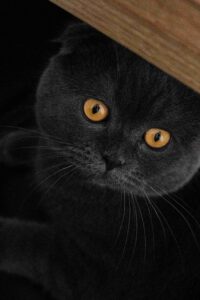
One glance at the Scottish Fold and you will understand why this enchanting breed is a beloved choice among cat enthusiasts. Their most distinguishing feature is, of course, their unique folded ears that give them an adorable, hat-like appearance. This remarkable characteristic, coupled with their playful and affectionate nature, makes them truly stand out in the world of domestic cats.
Unique Physical Traits
Scottish Folds come in both long-haired and short-haired varieties. They possess a medium-sized body, and their physical features include:
- Face: Round with prominent cheeks
- Eyes: Large and expressive, often in shades of copper or blue
- Ears: Unique since they fold forward, creating a distinct look akin to wearing a hat
- Coat: Soft and plush, available in a variety of colors and patterns, from solid to tabby
These physical traits not only contribute to their charm but also enhance their visual appeal, making them a standout breed.
| Trait | Description |
|---|---|
| Size | Medium |
| Weight | 6 to 13 pounds |
| Lifespan | 12 to 15 years |
| Coat Types | Long-haired and short-haired |
| Personality | Affectionate, playful, and friendly |
Personality and Temperament
Scottish Folds are often regarded as one of the most lovable cat breeds. Their affectionate nature makes them excellent companions. Here are some key personality traits:
- Playful: They enjoy engaging in playful activities, making them perfect for families with children.
- Affectionate: Scottish Folds form strong bonds with their owners, often following them around the house.
- Gentle: These cats have a calm demeanor, making them suitable for households with other pets.
- Curious: They possess an inquisitive nature, exploring their surroundings and entertaining themselves.
These traits show why they’re often referred to as “the hat-that-makes-you smile,” as their antics and personality can brighten anyone’s day.
Maintenance and Care
To ensure a happy and healthy life for your Scottish Fold, consider the following maintenance requirements:
- Grooming: Regular brushing is essential, especially for long-haired varieties, to prevent matting and hairballs.
- Vet Visits: Routine check-ups are crucial; genetics can influence their health, particularly in relation to their ears.
- Diet: A balanced diet, appropriate for their age and weight, is vital to prevent obesity and promote longevity.
Conclusion
Every cat lover dreams of a furry companion who is not only charming but also has a gentle nature. The Scottish Fold encapsulates these traits magnificently, boasting a unique appearance and a delightful personality that leaves a lasting impression. With their playful disposition and affectionate ways, they truly embody the essence of feline companionship, earning their nickname and enriching the lives of those fortunate enough to welcome one into their homes.
Japanese Bobtail: The Lucky Cat
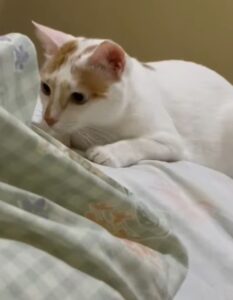
The Japanese Bobtail is a fascinating breed that holds a unique position in the world of feline companions. Known for its charming personality and distinctive appearance, this breed captivates enthusiasts and casual travelers alike. Its history is interwoven with Japanese culture, where it is often considered a symbol of good fortune, earning the moniker “lucky cat.”
Distinctive Features
One of the most identifiable traits of the Japanese Bobtail is its “bobbed” tail, which resembles a pom-pom rather than a traditional feline tail. This unique feature, coupled with their tall, slender body and striking coats, makes them a joy to behold. Below is a summarized listing of their key characteristics:
- Tail: Short and stubby; often curled.
- Ears: Large and upright, set far apart, giving them an alert expression.
- Eyes: Round and expressive; typically golden or blue.
- Weight:
- Males: 8-12 pounds
- Females: 6-10 pounds
- Coat Colors:
- Common colors include white, bi-color, and tricolor (Calico).
- Patterns can vary, showcasing rich diversity.
Temperament and Personality
The Japanese Bobtail is not just a pretty face; their demeanor is equally endearing. Renowned for their affectionate nature, these cats are known to form strong bonds with their human companions. Some notable personality traits include:
- Affectionate: Enjoy cuddling and snuggling.
- Playful: Display a youthful demeanor; love interactive toys and playtime.
- Social: Enjoy being around other pets and people.
- Intelligent: Quick learners, often picking up tricks and commands easily.
| Trait | Description |
|---|---|
| Affection Level | High – Enjoys human interaction |
| Energy Level | Moderate – Enjoys playtime, but also relaxed |
| Compatibility | Excellent with children and other pets |
Cultural Significance
In Japanese culture, cats, particularly the Japanese Bobtail, are viewed as symbols of good luck and prosperity. One of the most recognizable representations is the Maneki Neko or “beckoning cat,” which is often displayed in homes and businesses. The raised paw of this figurine is believed to invite wealth, luck, and success.
Care Requirements
While generally robust and healthy, Japanese Bobtails do require specific care to maintain their optimal health and happiness:
- Diet: A high-quality, balanced diet is essential. Look for cat food rich in protein to support their energy needs and overall health.
- Exercise: Regular playtime is crucial; consider engaging in interactive games that stimulate their minds and bodies.
- Grooming: Depending on the coat length, regular brushing may be needed, especially for those with longer fur.
Final Thoughts
The Japanese Bobtail combines beauty, charm, and an engaging personality, making it an exceptional companion. Their playful and affectionate disposition, along with their unique appearance, truly sets them apart in the feline world. Whether you’re drawn to them for their luck-bringing legacy or their delightful companionship, these “lucky cats” are sure to become beloved members of any household.
Abyssinian: The Energetic Explorer
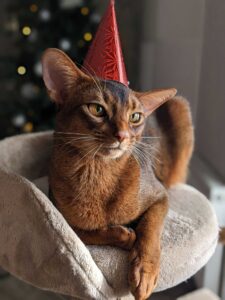
The Abyssinian cat, renowned for its playful nature and striking appearance, earns its status as a favorite among feline enthusiasts. As one of the most captivating domestic breeds, the Abyssinian is often referred to as the “Energetic Explorer” due to its insatiable curiosity and adventurous spirit.
Physical Characteristics
Abyssinians are truly stunning creatures with a unique coat that sets them apart from other breeds. Here’s what you can expect:
- Coat: The coat is short and dense, characterized by a unique “ticked” pattern—each hair has bands of color that give the breed a warm and vibrant appearance. The most common colors are:
- Ruddy
- Red
- Blue
- Fawn
- Body Structure: They possess a medium-sized, slender body that is muscular yet agile. Their athletic build contributes to their playful disposition.
- Eyes: Abyssinians have large, almond-shaped eyes that shine in various shades, including amber and green, enhancing their captivating expressions.
- Ears: Their large, tufted ears often resemble those of a wild cat, giving them a distinctly exotic look.
Temperament
Abyssinians are known not just for their looks but also for their vivacious personality. These cats are:
- Curious: They love to explore their surroundings, often seeking out high perches to survey their domain.
- Affectionate: While they enjoy their independence, Abyssinians are also loving companions who crave attention and interaction with their family members.
- Intelligent: Known for their problem-solving skills, they can quickly learn tricks or games. Their intelligence makes them ideal candidates for interactive play sessions.
Care and Maintenance
Caring for an Abyssinian is relatively straightforward, but certain steps will help maintain their health and happiness:
- Diet: A balanced diet rich in proteins and healthy fats is crucial for their energetic lifestyle. Consider a mix of dry and wet foods, particularly those formulated for active indoor cats.
- Exercise: Given their energetic nature, it’s essential to provide them with plenty of physical activity. Engage them in interactive play using:
- Laser pointers
- Feather wands
- Cat trees and climbing structures
- Grooming: While the short coat requires minimal grooming, weekly brushing can help reduce loose hair and keep their coat shiny.
Fun Facts
- Social Butterflies: Abyssinians usually get along well with other pets and can often be seen playing with dogs or other cats, showcasing their sociable nature.
- Leap Champions: Due to their athletic build, these cats are natural jumpers and climbers. They enjoy vertical spaces and can often leap to surprising heights.
Comparison Table: Abyssinian vs. Other Popular Breeds
| Feature | Abyssinian | Bengal | Maine Coon |
|---|---|---|---|
| Size | Medium | Medium-Large | Large |
| Coat Type | Short & Ticked | Short & Dense | Long & Fluffy |
| Temperament | Energetic & Social | Playful & Mischievous | Gentle & Affectionate |
| Grooming Needs | Low | Moderate | High |
| Lifespan | 12-15 years | 12-16 years | 12-15 years |
“Abyssinians are not just pets; they are vibrant companions that fill your life with joy and excitement.”
In summary, the Abyssinian cat is a perfect match for families or individuals looking for a lively, affectionate, and intelligent companion. Their exploratory spirit and playful demeanor make them an excellent addition to any household, bringing an endless supply of entertainment and love.

